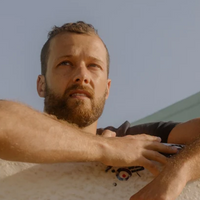Trends w/ Benefits is brought to you by MUD\WTR: the ritual-building company. Our :rise blend is a coffee alternative made from masala chai, cacao and adaptogenic mushrooms. Our :rest blend is a caffeine-free evening drink we made to help you rest and unwind in the evening.
Chronically breathing through your mouth can change the shape of your face. Children who primarily mouth breathe can develop a condition called adenoid face. Their faces develop with less musculature and bone density and become longer and skinnier, allowing less room for air passage through the nostrils. Mr. Burns, Professor Snape and other villains were likely afflicted with this condition.
Our hunter-gatherer ancestors typically had wider, and more powerful facial features than we do today. Anthropologists believe this is the case because children chewed on wild game and other tough foods back then, rather than slurping down soft foods like they do today. This constant jaw exercise widened the mouth, which allowed enough room for wisdom teeth to come through. Skeletal remains show that hunter-gatherers typically had perfectly straight teeth. Anthropologists believe that a wider face allowed hunter-gatherers to breathe through their noses more efficiently, and, like most exercises, the more they breathed through their noses, the stronger their nasal passageways became.
In contrast, somewhere between 25 percent and 50 percent of today’s population are chronic mouth breathers, which can result in a multitude of neurological and respiratory problems including snoring, sleep apnea and metabolic disease.
“The benefits of breathing through your nose are innumerable,” said James Nestor during an interview on The Joe Rogan Experience. Nestor authored the new book Breath: The New Science of a Lost Art. If you were to take your fist and imagine pushing it inside of your head, that’s about the volume of your nose and sinus cavities. “They call it the nasal conch because it looks like a seashell,” Nestor explained. Oxygen that moves through the nasal conch is slowed down, filtered, humidified and conditioned, which allows your lungs to absorb the oxygen more easily. Additionally, the nose produces nitric oxide, which is a vasodilator and helps battle viruses.
Dr. Richard Brown and Patricia Gerber developed a program to treat respiratory issues by training their patients to breathe for six seconds in, and six seconds out. That’s it. This was shown to be effective for 9/11 survivors who had a condition called "ground class lungs." Their lungs were filled with garbage and they were constantly coughing. By training themselves to use the six in, six out technique, it filtered their lungs and many of their issues were resolved.
Simly becoming conscious of your breathing patterns, like you’re doing as you read this, is a big first step. So many people stop breathing correctly the moment they sit down at a computer that researchers have actually coined a name for it: “email apnea.” Nestor recommends taking a few slow breaths through your nose as soon as you sit down in order to train yourself to keep that pattern going as you get lost in the daily grind. The longest period of unconscious breathing is when you sleep. If you wake up with a dry mouth, chances are you are spending your nights huffing dry air, rather than filtering it through your nose. In this case, Nestor recommends covering your mouth with a piece of tape while you sleep. You don’t need to hermetically seal your mouth closed like a kidnapping victim. Simply use a piece of scotch tape about the size of a stamp to train the jaw shut.
Most mammals breathe through their noses, even during strenuous activity. Dogs pant through their mouths for thermoregulation, not oxygen absorption. Although this is the case, we are taught that humans are the exception to the rule. It turns out, however, that you don’t absorb about 75 percent of the oxygen you breathe in. Quick, shallow breaths don’t allow your body to efficiently circulate oxygen. Breathing less frequently, but more deeply, allows your body to extract about 20 percent more oxygen from each breath. Dr. John Douillard did studies on cyclists who were typically taking 47 breaths per minute. By training them instead to breathe through their nose 14 times per minute, he was able to increase their endurance, performance and recovery. Some coaches have gone as far as forcing runners to take a mouth full of water, hold it for the entirety of their run, then spit it out when crossing the finish line.
The first time you attempt a workout while only nose breathing, you will likely feel like you are going to drown. I attempted a 20-minute nose-only workout using kettle bells and a jump rope. Toward the end, I began to panic breathe through my nose, grasping for short, shallow breaths—the kind you take moments before you sneeze. It’s important to understand, though, that the moment you feel the panicked urge to breath you still have a longtime before you’ll pass out. One free-diver friend of mine says, “When I feel the first urge to breathe, that’s when the work starts.”
Nose breathing is just one technique that has been shown to have health benefits. Another seemingly magical aspect to the breath is its ability to produce altered states of consciousness. A Netherlands super-athlete popularized a technique called The Wim Hof Method. He trains people to take 30 huge mouth breaths, exhale completely, and, on the final breath, hold for as long as possible. Then he has them repeat the process for three cycles. The simplicity of his method and the electric surge of energy that immediately results has allowed for mass adoption of the technique.
You are walking around with roughly the same body and brain as your ancestors had 200,000 years ago. Only in the last 10,000 years, though, have we shifted from hunter-gatherer living to industrial agriculture. Many modern breakthroughs in health and longevity are the result of replicating behavior from our ancestors: For instance, adopting more primitive diets diversifies the gut biome; opening your windows at night to make your room colder allows for deeper sleep; and defecating using a squatty potty can resolve digestion issues. Breathing correctly is just another example of looking back to find our way forward.
By: Kyle Thiermann




